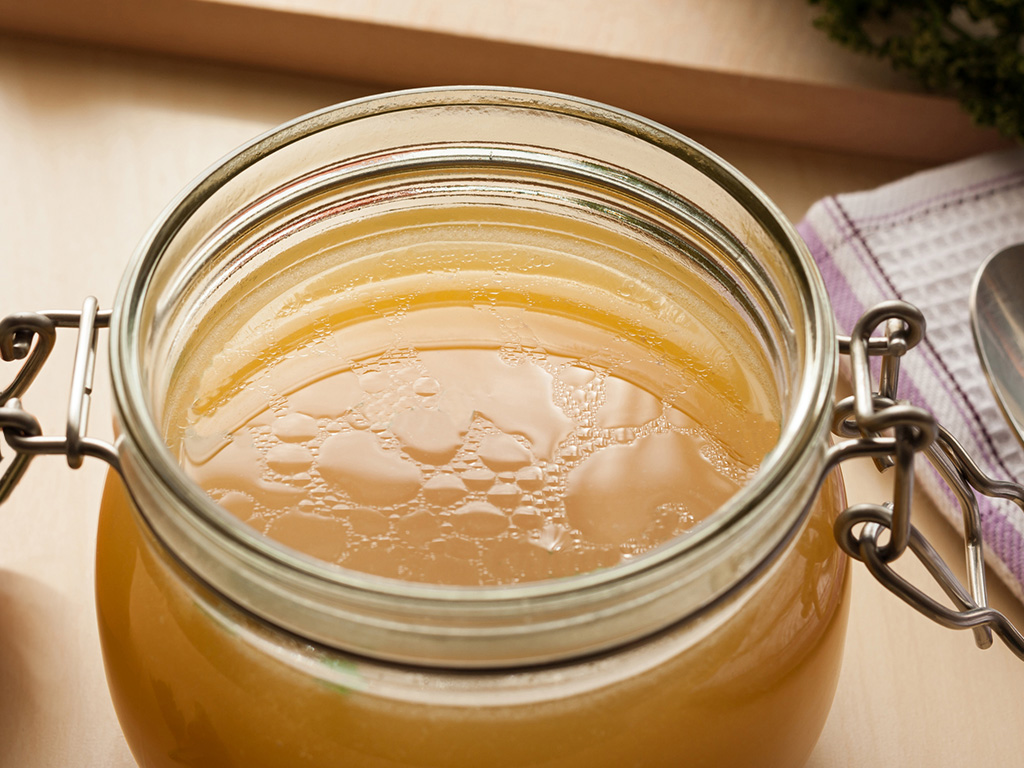Bone broth, which is easily digestible, essential, anti-inflammatory, gut healing nutrients such as amino acids the building blocks of protein, easily absorbable forms of minerals such as calcium, magnesium, sulphur, silicon, phosphorus and chondroitin, glucosamine & gelatin which have been released into the water as the bones have been simmered.
Can how this stock be so nutritious?
- A healthy gut and healthy digestion; the amino acid glycine stimulates the production of stomach acid and glutamine, another important amino acid which helps to maintain and restore the integrity of the gut lining. There is a strong link between gut health and overall health.
- Joint Health from the strengthening nutrients including chondroitin, glucosamine, magnesium and calcium, together with proteins (including gelatine which has been broken down from collagen) which provide the body with raw materials it needs for healthy bones and joints.
- Liver Detoxification. The liver is the organ of detoxification and in the modern world the liver has a high toxic load to process from the environment, such as polluted air, chemicals in household cleaners, fertilised grass, processed foods and drugs. The amino acid glycine and mineral sulphur found in bone broth play an important role in supporting liver detoxification.
How to Make Bone Broth
Ingredients
A couple of chicken carcasses (organic, grass-fed bones are best)
A splash of Raw Apple Cider Vinegar
1 Large onion, roughly chopped
2 carrots, roughly chopped
3 celery stalks, roughly chopped
1 whole garlic bulb
Flat leaf parsley – 1 -2 handfuls
1 tbsp black peppercorns, crushed lightly
- Use bones from a whole chicken or whole carcass. Chicken carcasses can be purchased from many on-line food retailers or your local butcher. However you can also use any bones you wish – knuckle and foot bones are excellent. Bones from meat you have already roasted are also great to use.
- Rinse the chicken carcasses (or equivalent) and add to a large saucepan or slow cooker and completely cover with filtered water, along with the rest of the ingredients
- The addition of raw apple cider vinegar (approximately 1 teaspoon for every 4.5 litres of water or the juice of a lemon to the water). This will help to extract all the goodness out of the bones
- Bring to the boil then simmer on a low heat for at least 4 hours but you can simmer for up to 24 hours (or longer!). The longer you cook the broth the more the flavours will develop. This process doesn’t need to take place continuously – you can simmer during the day and turn off the stove at bedtime, turning it back on again in the morning. Stir occasionally while it cooks. I will often cook this for 3 days.
- Skim off the foam that develops
- Ideally when the meat starts to fall off the bones (at approximately 2.5 hours) remove the meat and top up with a little water. However this may be longer, especially if you are simmering at a lower temperature – by four and a half hours all the meat should be off the bones.
- After the required cooking time, allow to cool slightly; remove the bones and discard and strain the remaining liquid. Allow the broth to cool . The cooked bone broth will be liquid but once cooked the broth will congeal into a thick jelly-like substance (from the gelatine). A layer of fat will form on the top of the cooled broth. You may want to discard this but equally if you are using bones of healthy animals (organic and grass fed) then this can be used as a cooking oil for meat, poultry an vegetable dishes.
- Store in the fridge for up to four or five days. I normally put mine in a kilner jar or you can freeze (for up to 3 months) in small containers or ice cube trays for easy use.



